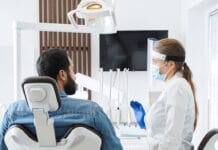Chronic halitosis is embarrassing for everyone. A dental patient with bad breath may feel too embarrassed to step foot inside a dentist’s office, and the dental team may feel uncomfortable bringing the issue to the patient’s attention. Oral health professionals, though, have the responsibility to feel confident in effectively and gently helping patients find a solution for the halitosis.
Sometimes the Answer is Simple
Encouraging dental patients to adopt better home hygiene and a recare routine is the first step in combatting bad breath. During their next prophy, be sure to discuss the systemic effects of periodontal infections, including how the inflammations impact heart health, reproductive wellness, and even change the way our breath smells. Reassure patients that, by focusing along the gumlines and scheduling regular preventive care, they can easily promote a healthier and fresher mouth as well as decrease strain on their overall immune system.
Adopt an “all or nothing” approach to your oral hygiene education discussion. The thorough approach will help when it comes to including sensitive or embarrassing topics.
For example, if a patient has moderate subgingival calculus, consider discussing how a water flosser or interdental brushes can clean those spaces to help with gingivitis, periodontitis, and even halitosis, especially since these tools can reach much deeper than conventional flossing.1 By giving an emotional reason to use a physical preventive care tool, you’ve made the connection the patient needs to actively change their oral hygiene habits.
A Sign of an Underlying Medical Problem?
Lingering halitosis or changes in the way someone’s breath smells can be linked to non-dental conditions like:
- Sinusitis, allergies, or a post-nasal drip
- Diabetes
- Reflux disease
- Lung diseases (including asthma, cystic fibrosis)
- Bowel obstruction
- Tonsil stones
- Certain cancers or a metabolic disease
These medical conditions, of course, also have other symptoms besides the risk of halitosis. By completing a thorough medical assessment and screening during every recall exam, hygienists can help connect the dots for their patients.
For example, if a patient is presenting with halitosis and acid erosion in the cusps of their molars, you could ask them if they’re experiencing any heartburn symptoms. More than likely, halitosis isn’t going to be the only physical symptom of the coexisting condition. The better you are at inquiring about underlying health factors, the less you’ll have to rely on discussing the bad breath separately.
Introduce New Products and Findings
What can patients do to actively improve their breath within the scope of oral care? Think about the resources you have on hand in your practice and introduce them during the recall appointment.
For example:
“You know what, Jan? I noticed that you have a pretty thick film across the top of your tongue. I don’t know if you’ve noticed any changes in the way your food tastes or how fresh your mouth feels, but sometimes those thick residues can interfere with that. I’ve got this really cool tongue scraper that you need to see. I started using one about six months ago, and you wouldn’t believe the stuff that comes off with it! Here, I’ll show you how to use it…”
Or,
“Jan, I know you love reading about natural health remedies. I’ve got to tell you about this really neat piece of literature that I read last week discussing oral probiotics. It turns out that certain probiotic strains can actually help prevent bad breath and might even help with managing periodontal disease. I thought that was so neat!”2
Or,
“I just started using this new mouthwash that I love. It just makes my mouth feel so clean after I brush and floss, and my breath is fresh for hours after. I’ve got some samples if you want to try some!”
Talk About it Without Pointing it Out
Just like other touchy subjects, it can be difficult to talk about halitosis or other problems without causing an awkward moment in the operatory. But by being consistent in how you mention concerns and group them together with others, it’s possible to communicate what the patient really wants to know about without narrowing the topic of conversation. Chances are, your patient is probably already self-conscious about having halitosis, especially if they doused themselves in mouthwash right before the appointment.
Our role is to help patients in a tender, understanding manner without making them more uncomfortable than they already are. When we use phrases that include “bad breath,” it will perk up their interest, even though the halitosis isn’t the subject of the conversation. Chances are, you’ll notice a big improvement between now and their next appointment.
Now Check Out the Peer-Reviewed, Self-Study CE Courses from Today’s RDH!
Listen to the Today’s RDH Dental Hygiene Podcast Below:
References
- Ng, E., Lim, L.P. An Overview of Interdental Cleaning Aids and Their Effectiveness. Dent J (Basil). 2019; 7(2): 56. https://www.ncbi.nlm.nih.gov/pmc/articles/PMC6630384/
- Karbalaei, M., Keikha, M., Kobyliak, N., et al. Alleviation of halitosis by use of probiotics and their protective mechanisms in the oral cavity. New Microbes New Infect. 2021 Apr 23; 42: 100887. https://pubmed.ncbi.nlm.nih.gov/34123388/












